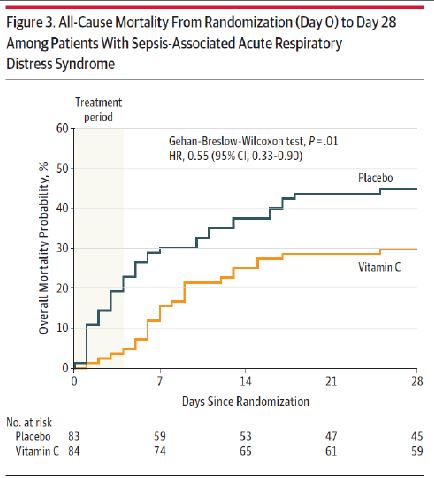
WILLIAM RAU
There is a safe, long-standing drug that is showing success with septic shock, a serious infection that causes our immune systems to go haywire. This is timely because sepsis can be complicated by acute respiratory distress syndrome (ARDS), the same deadly complication claiming many COVID-19 victims. Severe sepsis, with death rates of 30% to 45%, is increasing worldwide. As a result, over $1 billion has been spent on clinical trials. All trials with standard drugs have failed. Like Alzheimer’s, sepsis initiates multiple, interacting, adverse effects that single-target drugs cannot stop.
What is proving partially effective for sepsis is high-dose intravenous C or IVC:
- High-dose sodium ascorbate is not a vitamin; it is a powerful pleotropic or multimodal drug that
- Combats at least 15 different adverse effects of the infection (Table 1, Kashioris et al. 2020) and
- Cuts the death rate significantly.
Longer treatment with higher IVC doses may yield better results. And we will find out from two 7-day IVC trials now underway in China. (≥12 & 24 grams per day: Carr 2020; Muacevic & Adler 2020). Longer treatment times are motivated by the results shown in the graph from the CITRIS-ALI Clinical Trial (Fowler III, 2019).
Note in the graph how 16 grams per day IVC (my body weight) stops sepsis in its tracks through day 4 when IVC infusions stopped. Then, sans IVC, cumulative mortality increases in mostly larger steps through day 9; deaths then increase more slowly through day 16.
If I were to become hospital-bound with COVID-19, I would insist on initiation and continuation of high-dose IVC until I could walk home or became terminal. The Chinese seven-day experiments represent improved treatment length, but seven days might not be long enough.
A patient controls treatment, not a doctor. If MDs reject high-dose IVC, a patient need not sign the hospital waiver. Patients’ legal rights put hospital admittees in the driver’s seat. The only thing safer than IVC at these doses is distilled water. Medieval medical folklore need not dictate treatment.
Back in 1948, Dr. Frederick Klenner was successfully treating polio – another viral infection – with high-dose IVC while other MDs waited for vaccines. His words (Saul 2007):
“Some physicians would stand by and see their patient die rather than use ascorbic acid because in their finite minds it exists only as a vitamin.”
To reiterate, IVC delivers a powerful pleotropic drug. If COVID-19 comes after you like a charging grizzly, don’t choose a pea shooter. Go for a .338 Magnum.
William Rau is an Illinois State University emeritus professor of sociology.
References
Carr, Anitra C. 2020 (Apr 7). A new clinical trial to test high-dose vitamin C in patients with COVID-19. Critical Care; https://www.ncbi.nlm.nih.gov/pmc/articles/PMC7137406/
Fowler III, Alpha A., et al. 2019. Effect of Vitamin C Infusion … on Patients with Sepsis and Severe Acute Respiratory Failure: The CITRIS-ALI Randomized Clinical Trial. Journal of the American Medical Association; https://www.ncbi.nlm.nih.gov/pmc/articles/PMC6777268/
Kashiouris, Markos G., et al. 2020 (Jan 22). The Emerging Role of Vitamin C as a Treatment for Sepsis. Nutrients; www.ncbi.nlm.nih.gov/pmc/articles/PMC7070236
Muacevic, Alexander & John R. Adler. 2020 (Apr 6). A Comprehensive Literature Review on the Clinical Presentation and Management of the Pandemic Coronavirus Disease (COVID-19). Cureus; https://www.ncbi.nlm.nih.gov/pmc/articles/PMC7138423
Saul, Andrew W. 2007. The Pioneering Work of Frederick Robert Klenner, M.D. Journal of Orthomolecular Medicine; http://www.doctoryourself.com/klennerbio.html


Recent Comments